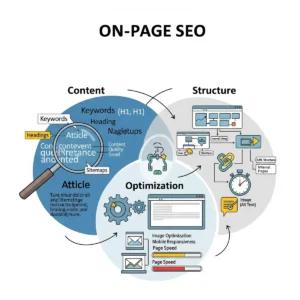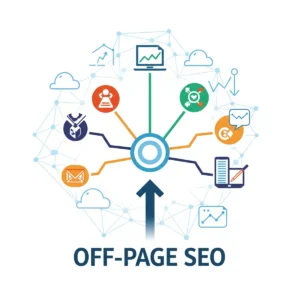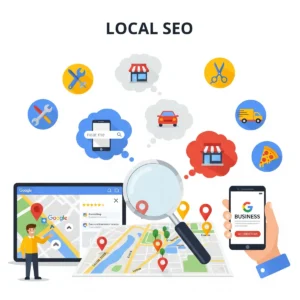Why does your website need SEO-optimized content?
In my experience working on different projects, I’ve seen that SEO-optimized content is one of the most proven ways to make a website more visible in search results. An optimized copy filled with the right keywords helps a business show up for the queries that customers are actually typing when searching for a product or service. By naturally weaving in target terms, the content becomes easier for people and Google to recognize, bringing in steady organic traffic to your site and eventually boosting sales. The real benefits of SEO copywriting go beyond rankings—it’s also about crafting high-quality material that connects with visitors. I’ve noticed that internet users often prefer learning about a company through blog posts rather than advertisements, which makes content even more important for a business owner who wants to focus on creating something optimized that not only informs but also educates an audience. This keeps the brand visible while helping people connect with it on a deeper level.
Why is SEO Copywriting important? What is the importance of SEO copywriting
- To sell through your website, you need targeted traffic that delivers an outstanding conversion rate.
- Copywriting is an old field and profession, but the concept of SEO is relatively new, reshaping how business works online.
- People usually find a website via search engines, websites that link back, or social media.
- Converting visitors into paying customers and clients requires trust—you need to convince them, make them feel confident, and ready to spend money.
- A compelling copy that persuades is the job of a skilled copywriter.
- SEO writers focus on improving search engine rankings with optimized content.
- When conventional writing is combined with SEO, it becomes SEO copywriting, offering visibility and conversions together.
From my experience, the true value of SEO copywriting lies in its ability to bring targeted traffic while also building trust with your visitors. It blends the timeless art of copywriting with the modern power of SEO, ensuring your website not only ranks in search engines but also convinces and persuades people to become loyal customers.

Why is SEO copywriting important?
SEO copywriting plays a vital role in bridging the gap between attracting search engine traffic and turning that traffic into real business results. It combines persuasive writing with optimization techniques, making it possible for a website to rank and still engage its visitors.
- Search engine traffic is the backbone of online growth, and SEO copywriting ensures you don’t miss it.
- The concepts of copywriting and SEO when combined remove the need for separate web pages to draw and convert visitors.
- Turning visitors into paying customers and clients requires more than traffic—it requires strategy.
- Ignoring balance can be counter-productive because people may leave your website without choosing to explore further.
- Success comes from focusing on delivering quality writing that serves both search engines and readers.
In my experience, businesses that master SEO copywriting achieve both visibility and conversions. By blending quality writing with optimization, you ensure your website not only appears in search engines but also builds trust with visitors who are ready to become customers.
How is SEO copywriting different from normal copywriting?
SEO copywriting is not just about persuasive words—it’s about attracting targeted traffic through search engines like Google while ensuring your website provides value. Unlike traditional copy that focuses only on selling, SEO copywriting ensures the right topic, phrase, and expressions appear naturally so your link is relevant and ranks.
Many writers miss this balance and fall into traps like keyword stuffing, over-optimizing copy, or using keywords with the wrong frequency, which can get content penalised. A skilled copywriter understands how to keep keywords contextually relevant without letting them become overused, ensuring the content both converts and ranks.
Normal copywriting doesn’t rely on primary or secondary keywords strategically placed. Instead, it often follows conventions, guidelines, or even randomness, making it less reliable for search visibility.
From my own work, I’ve seen how SEO copywriting delivers consistent growth compared to normal copywriting. By maintaining the right balance between keyword placement and compelling storytelling, businesses not only achieve visibility but also earn the trust of real visitors who are ready to act.

- SEO copywriting attracts targeted traffic through search engines like Google while providing value on your website.
- Unlike traditional copy that focuses only on selling, it ensures the right topic, phrase, and expressions appear naturally so your link is relevant and ranks.
- Many writers miss this balance and fall into traps like keyword stuffing, over-optimizing, or using keywords with the wrong frequency, which can get content penalised.
- A skilled copywriter keeps keywords contextually relevant without letting them become overused, ensuring content both converts and ranks.
- Normal copywriting doesn’t rely on primary or secondary keywords strategically placed; it often follows conventions, guidelines, or randomness, making it less reliable for search visibility.
- From experience, SEO copywriting delivers consistent growth compared to normal copywriting.
- Maintaining the right balance between keyword placement and compelling storytelling helps businesses achieve visibility and earn the trust of visitors ready to act.
Why you need SEO copywriting to improve your search engine rankings
SEO copywriting is essential in a world where search engine algorithms are constantly changing to serve users better. Updates like Panda from Google showed how websites can lose ranking if quality and relevance in content aren’t maintained. Understanding keywords, patterns, and how the algorithm analyzes terms is crucial for getting ranked for the right purpose and intent.
A strong website requires copywriting that considers crawling, pages, and monthly resources, making your content accessible to both humans and search engines. Targeted key phrases, headlines, informative and engaging content, conversational tone, and proper structure with headers, subheadings, internal and external links, meta tags, descriptions, density, and images with alt attributes all help optimize performance. Avoid keyword stuffing, duplication, or poorly sprinkled keywords; instead, place them strategically to convey meaning to spiders and crawlers.
SEO copywriting also ensures readability, strong user experience, and a consistent brand voice. Call-to-action (CTA) statements), unique and original content, and ongoing monitoring, analysis, and refinement improve performance over time. By focusing on educating users while also selling through marketing, pitch, and subtle advertisements, your web pages attract higher traffic, achieve better rankings, and provide meaningful information, solutions, and problem-solving for people.
From my experience, businesses that invest in SEO copywriting see measurable improvements in rankings and traffic. By following best practices in content structure, keyword placement, and user-focused writing, your website not only climbs in search engines but also engages readers effectively.
But does SEO copywriting only cater to the search engines?
SEO copywriting is not just about getting ranked; it’s about serving visitors and humans who drive real business and money. The importance of SEO copywriting lies in balancing content for online users while still achieving higher search engine rankings through optimization. A professional copywriter ensures a website appeals to both robots and spiders without overloading the web page with keywords, key phrases, anchor texts, or header tags.
Poorly managed stuffing can get content blocked or downgraded by Google, while proper placement of promising keywords and thoughtful efforts prevent phenomena like pogo sticking. Effective SEO copywriting helps convert leads into customers by delivering value in a way that is compatible with both viewers and search engines. Strategically placing keywords in the right places, ensuring they connect, inform, and convince, and maintaining optimal length and balance supports both traffic and conversions.
A holistic approach highlights the strength and purpose of your content. Writing with a clear mission statement helps you achieve your goals, following a structured process that reflects professional knowledge and experience to improve conversion rate. Using tools, subject matter expertise, longtail keywords, and understanding your persona or target customer/client probability ensures your content is focused and effective. Avoid over-accommodating multiple personae; instead, create a natural conversation as if sitting across a table, which enhances information delivery and educational value.

- SEO copywriting serves both ranked positions and visitors, not just humans.
- Balances content for online users while achieving higher search engine rankings through optimization.
- Professional copywriter ensures a website appeals to robots and spiders without overloading web pages with keywords, key phrases, anchor texts, or header tags.
- Avoid stuffing which can get content blocked or downgraded by Google.
- Proper placement of promising keywords prevents pogo sticking and supports converting leads into customers.
- Strategically placing keywords to connect, inform, and convince, while maintaining optimal length and balance, supports traffic and conversions.
- A holistic approach emphasizes strength and purpose with a clear mission statement to achieve goals.
- Following a structured process reflects professional knowledge and experience to improve conversion rate.
- Using tools, subject matter expertise, longtail keywords, and understanding the persona or target customer/client probability ensures content is focused.
- Avoid over-accommodating multiple personae; write as if in a natural conversation across a table to enhance information delivery and educational value.
7 steps to get perfect SEO content that users and Google love
Here’s our process from start to finish:
- Intake form: Fill out a quick form to help us understand which SEO copywriting and content optimization services you need, including questions about your goals, content types, preferred language, and more.
- Audience analysis: Analyze your target audience (CA) to define needs, search intent, pain points, and behavior, ensuring content resonates and drives action.
- Keyword research: Conduct keyword research using tools like Ahrefs to identify high-traffic, important keywords for your business. Provide a list of terms with the greatest traffic potential.
- Content brief: Prepare a detailed content brief including target keywords, structured outline, content type, minimum word count, language style, and any special requirements or guidelines.
- Copywriting: Our writers create SEO content, whether writing new articles for your blog or optimizing existing web pages on your site.
- Proofreading & editing: Editors review content for compliance with the brief, SEO best practices, natural keyword usage, accurate information, and overall quality.
- Results: Deliver SEO-optimized text reviewed by an SEO specialist and polished by an editor. Clients can review, provide feedback, and request any changes.
Want to improve your search engine positioning? Let’s talk! Reach out today at info@ashirdigitals.com“
FAQs About SEO Copywriting
Q1: What is the intake form for?
A1: The intake form helps us understand your goals, the types of content you need, your preferred language, and other details to tailor our SEO copywriting services to your business.
Q2: Why is audience analysis important?
A2: Audience analysis identifies your target audience’s needs, search intent, pain points, and behavior, ensuring the content resonates with them and drives meaningful action.
Q3: How do you conduct keyword research?
A3: We use tools like Ahrefs to find the most important keywords for your business, identifying terms with the highest traffic potential to optimize your content effectively.
Q4: What is included in the content brief?
A4: The content brief includes target keywords, a structured outline, content type, minimum word count, preferred language style, and any special requirements or guidelines for the copywriters.
Q5: How does the copywriting process work?
A5: Our writers create SEO-friendly content, whether it’s producing new articles for your blog or optimizing existing web pages, ensuring it aligns with your content strategy.
Q6: What happens during proofreading and editing?
A6: Editors review the content to ensure it meets all guidelines, follows SEO best practices, uses keywords naturally, and provides accurate, high-quality information.
Q7: What can I expect in the final results?
A7: You’ll receive SEO-optimized text reviewed by an SEO specialist and polished by an editor. You can then review the content, provide feedback, and request any necessary changes.










